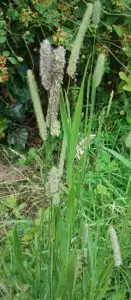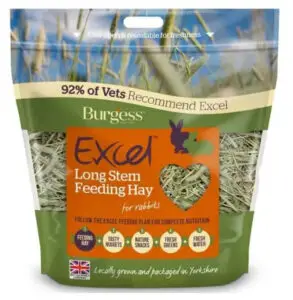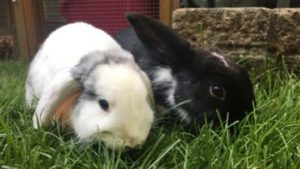Introduction
Being a newcomer to the world of rabbits, I asked the pleasant assistant in the pet store what we needed to feed our rabbits. We talked first about pellets (only an eggcup) and treats, but then moved on to the main part of any rabbit’s diet, hay.
‘You need Timothy hay’, she told us.
‘What?’
‘Timothy hay’ she repeated confidently.
‘Oh, Ok,’ I replied, and sure enough, there were some bales marked ‘Timothy’.
‘Must be some brand-name’ I thought to myself. But it wasn’t.
Timothy hay, to my surprise, is a type of hay. But this led to a range of questions – what is Timothy hay? Why is it called Timothy? And why do my rabbits need Timothy hay?
Timothy hay, named after an American farmer of the eighteenth century, is a high fibre, high energy, low protein, low calcium type of grass hay that helps your rabbit’s digestion and teeth.
Here’s some more information on what Timothy Hay is, why it’s called Timothy, and why it’s so good and important for your rabbit.
What is Timothy Hay?
Timothy hay is a type of grass hay that is great for feeding both rabbits and horses. It can grow up to around 1.5m (about five foot tall), and is quite rough and stalky. It can come in three varieties, depending on which cut of the season you buy. Timothy hay is good for rabbits as provides fibre and protein with low calcium. Rabbits need the fibre both for their teeth and their guts.
Timothy hay comes in three different cuts, which vary a bit from each other:
- First cut is the roughest and highest in fibre, and slightly lower in nutritional value.
- Second cut is a balanced amount of fibre and protein.
- Third cut is softer and greener, with relatively less fibre and more protein.
Having said that, the Timothy hay that I found on sale in pet shops and the local supermarket didn’t say which cut it had come from (maybe a mixture?) so I wouldn’t worry too much about this.
Types of hay

Timothy grass. Credit Blokenearexeter [CC0]
I thought hay was hay, but I was wrong. You can get a range of different types, but they fall into two broad categories: legumes and grasses. Timothy hay is a grass hay.
Another type of grass hay is meadow hay. This is softer than Timothy hay, and may include some edible plants such as dandelions. Because it contains a variety of plants, it can also be a bit more variable in contents than Timothy.
Legumes include alfalfa hay and clover. Alfalfa is greener, and high in protein and calcium. It may be suitable for younger rabbits (always check with a vet), but mature rabbits need less calcium – and too much is bad for them (see below).
Here’s a chart of typical values for the three types.
% Timothy Meadow Alfalfa
Fibre 30 30 30
Protein 6 7 16
Calcium 0.4 0.6 1.2
You can get Timothy hay from a variety of places, and the values will vary a little. Our local supermarket stocks bales of Timothy in the pet aisle, and of course so do most pet stores.

This is the hay we buy. It’s 100% Timothy hay – but they only tell you that on the back of the packaging. Weird.
We get Burgess Excel Long Stem Feeding Hay in 1kg (2.2lb) bags. Bizarrely, you have to search quite hard on the packaging before you find it that it is 100% Timothy Hay. We get our hay from our local Jollyes, who also have an online service.
You can also get Timothy hay from Amazon UK and Amazon US who will deliver to your door.
Why is it called Timothy hay?
The earliest account I could find comes from a 1949 book on crops. A grass from Europe (called cat’s tail) ended up in the eastern states, and became well-known when it was cultivated and sold by a farmer called Timothy Hanson.
Here’s the account:
‘The most important hay grass in America now is timothy. It was first grown by a man named Herd prior to 1720 near the Piscataqua River mouth in New Hampshire. It was introduced from England where it was found growing in waste places and was known as cat’s tail grass. Early records indicated that it was known as herd’s grass in the New England area. Timothy seed was taken to New York, Maryland, Virginia and North Carolina by a Timothy Hanson who lived near Portsmouth, New Hampshire. It was widely accepted in these states and became known as Timothy Hanson’s grass, which was later shortened to timothy. Jared Elliot sent seed of it to Benjamin Franklin in 1747, and when it was planted and grown Franklin described it as ‘mere timothy’. Large portions of the eastern part of the United States were planted to timothy by the colonists, and it has been the dominant hay grass in this region ever since.’
Gilbert H. Ahlgren, 1949, Forage Crops, New York: McGraw-Hill, p7.
You can also see an early reference to timothy hay in this 1859 newspaper article.
The Latin classification name for timothy grass is Phleum pratense. Knowing this allows us to access all sorts of databases and information (if you want to go further). For example, you can see the distribution worldwide of timothy grass here.
Three reasons why Timothy hay is so good for your rabbit
 One of my questions was ‘why is Timothy hay good for rabbits?’ When I searched around, I came across three different but important reasons:
One of my questions was ‘why is Timothy hay good for rabbits?’ When I searched around, I came across three different but important reasons:
Reason 1 – fibre
Hay is the most important part of a rabbit’s diet, and the fibre part is essential. You know how we are always advised to make sure we get fibre in our diet? And so you might choose wholemeal bread or eat a high fibre cereal, and this helps keep us ‘regular’. This is even more important for our bunnies, who have eating systems that are designed around a high fibre intake. The high fibre content helps makes sure that their intestines don’t clog up (gastrointestinal stasis). Gastrointestinal stasis is extremely serious – even fatal. A diet of fibrous hay helps avoid this.
Reason 2 – teeth
High fibre hay also helps keep your bunny’s teeth healthy. A rabbit’s teeth can grow up to 5 inches in a year (or 3mm a week) – problems start when the teeth grow faster than eating wears them down.
One type of problem is when the teeth grow too long – they can make it harder for your bunny to breathe, as the teeth start to block nasal passages.
The second problem is when the teeth aren’t smoothed down by eating rough food. Without eating rough hay and grass, rabbits can develop sharp bits on their teeth, called spurs. These can be painful for the rabbit. To avoid using that tooth, the rabbit then starts overusing other teeth, and changing the way they chew. So one small sharp point can lead to problems with the entire mouth, including other teeth, ligaments and muscles.
So the coarse fibres in hay are not only good for your rabbit’s intestines, but also help keep their teeth healthy.
This is also why providing toys for your rabbit to chew on is a good idea – not only fun, but good for their mouths. You can see some of our favourite rabbit toys in our post here.
Reason 3 – calcium
This was the reason that surprised me the most when I did some investigating. It turns out that rabbits are very efficient at extracting calcium from the food they eat. Most animals only absorb a little from the food eaten, and then excrete a small amount. Rabbits, unusually, try to absorb all the calcium from the food they eat. Then, up to nearly half they excrete in their urine. If they have too much calcium, their urine may turn chalky as their bodies try to get rid of the excess. In the worst case, this can lead to urinary stones (urolithiasis).
Timothy hay is relatively low in calcium, and so ideal for mature rabbits. They can be given unlimited quantities safely.
How much hay should I give my bunny?
You can give as much hay as you like to your furry friend – but make sure it’s enough. A rabbit eats a bundle about the size of its own body every day. For more information on the best diet for pet rabbits, see this advice from the RSPCA.
Conclusion
So that’s what I found out about Timothy hay. It’s named after an American; it’s a type of tall, fibrous grass that’s high in fibre and low in calcium, and it’s important for my bunnies because it’s good for their guts and their teeth.
Rabbits eat more than hay – you can also give them a handful of greens every day. Want to know what herbs are safe for your bunny? We have a post that lets you know what herbs are OK, and what might harm your rabbit.
Want to know what fruit you can give your bunny as a treat (and how much you should be giving them)? Check out our in-depth guide on what fruit are safe for rabbits.
And we also have a guide to what vitamins and minerals rabbits need.


